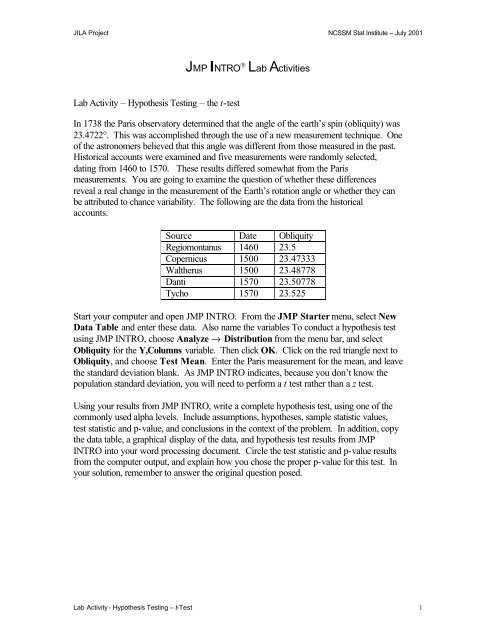JMP INTRO ® Lab Activities Lab Activity â Hypothesis Testing â the t ...
JMP INTRO ® Lab Activities Lab Activity â Hypothesis Testing â the t ...
JMP INTRO ® Lab Activities Lab Activity â Hypothesis Testing â the t ...
- No tags were found...
Create successful ePaper yourself
Turn your PDF publications into a flip-book with our unique Google optimized e-Paper software.
JILA Project NCSSM Stat Institute – July 2001<strong>JMP</strong> <strong>INTRO</strong> ® <strong>Lab</strong> <strong>Activities</strong><strong>Lab</strong> <strong>Activity</strong> – <strong>Hypo<strong>the</strong>sis</strong> <strong>Testing</strong> – <strong>the</strong> t-testIn 1738 <strong>the</strong> Paris observatory determined that <strong>the</strong> angle of <strong>the</strong> earth’s spin (obliquity) was23.4722°. This was accomplished through <strong>the</strong> use of a new measurement technique. Oneof <strong>the</strong> astronomers believed that this angle was different from those measured in <strong>the</strong> past.Historical accounts were examined and five measurements were randomly selected,dating from 1460 to 1570. These results differed somewhat from <strong>the</strong> Parismeasurements. You are going to examine <strong>the</strong> question of whe<strong>the</strong>r <strong>the</strong>se differencesreveal a real change in <strong>the</strong> measurement of <strong>the</strong> Earth’s rotation angle or whe<strong>the</strong>r <strong>the</strong>y canbe attributed to chance variability. The following are <strong>the</strong> data from <strong>the</strong> historicalaccounts.Source Date ObliquityRegiomontanus 1460 23.5Copernicus 1500 23.47333Wal<strong>the</strong>rus 1500 23.48778Danti 1570 23.50778Tycho 1570 23.525Start your computer and open <strong>JMP</strong> <strong>INTRO</strong>. From <strong>the</strong> <strong>JMP</strong> Starter menu, select NewData Table and enter <strong>the</strong>se data. Also name <strong>the</strong> variables To conduct a hypo<strong>the</strong>sis testusing <strong>JMP</strong> <strong>INTRO</strong>, choose Analyze fi Distribution from <strong>the</strong> menu bar, and selectObliquity for <strong>the</strong> Y,Columns variable. Then click OK. Click on <strong>the</strong> red triangle next toObliquity, and choose Test Mean. Enter <strong>the</strong> Paris measurement for <strong>the</strong> mean, and leave<strong>the</strong> standard deviation blank. As <strong>JMP</strong> <strong>INTRO</strong> indicates, because you don’t know <strong>the</strong>population standard deviation, you will need to perform a t test ra<strong>the</strong>r than a z test.Using your results from <strong>JMP</strong> <strong>INTRO</strong>, write a complete hypo<strong>the</strong>sis test, using one of <strong>the</strong>commonly used alpha levels. Include assumptions, hypo<strong>the</strong>ses, sample statistic values,test statistic and p-value, and conclusions in <strong>the</strong> context of <strong>the</strong> problem. In addition, copy<strong>the</strong> data table, a graphical display of <strong>the</strong> data, and hypo<strong>the</strong>sis test results from <strong>JMP</strong><strong>INTRO</strong> into your word processing document. Circle <strong>the</strong> test statistic and p-value resultsfrom <strong>the</strong> computer output, and explain how you chose <strong>the</strong> proper p-value for this test. Inyour solution, remember to answer <strong>the</strong> original question posed.<strong>Lab</strong> <strong>Activity</strong> - <strong>Hypo<strong>the</strong>sis</strong> <strong>Testing</strong> – t-Test 1
JILA Project NCSSM Stat Institute – July 2001<strong>JMP</strong> <strong>INTRO</strong> ® <strong>Lab</strong> <strong>Activities</strong>Teacher Notes<strong>Lab</strong> <strong>Activity</strong> – <strong>Hypo<strong>the</strong>sis</strong> <strong>Testing</strong> – <strong>the</strong> t-testObjectives:• Gain familiarity with some of <strong>the</strong> basic operational tools of <strong>JMP</strong> <strong>INTRO</strong>.• Use <strong>JMP</strong> <strong>INTRO</strong> to conduct a hypo<strong>the</strong>sis test for a mean when <strong>the</strong> standarddeviation is unknown.• Create a word processing document, incorporating displays from <strong>JMP</strong> <strong>INTRO</strong>.Time Required:Materials:30 minutes<strong>Hypo<strong>the</strong>sis</strong> <strong>Testing</strong> - <strong>the</strong> t-test student activity directionsPrerequisites:• Students should have basic knowledge of how to use <strong>JMP</strong> <strong>INTRO</strong>.• Students should have experience conducting tests of hypo<strong>the</strong>sis by hand and/orwith graphing calculators for a mean when <strong>the</strong> standard deviation is unknown.• Students should have experience writing conclusions in <strong>the</strong> context of <strong>the</strong>problem for hypo<strong>the</strong>sis tests.• Students should have had experience creating a data table in <strong>JMP</strong> <strong>INTRO</strong>.<strong>JMP</strong> <strong>INTRO</strong> Notes:• <strong>JMP</strong> <strong>INTRO</strong> includes an extensive online help system. It contains a table ofcontents and/or can be used to search for a specific topic. In addition, <strong>JMP</strong><strong>INTRO</strong> has context sensitive help. You can access it by selecting <strong>the</strong> help tool (?)from <strong>the</strong> tools toolbar and clicking inside a data table or report. <strong>JMP</strong> <strong>INTRO</strong>opens help specific to <strong>the</strong> clicked-on item.• Students need to choose <strong>the</strong> correct p-value based on <strong>the</strong>ir alternate hypo<strong>the</strong>sis. Abrief discussion of <strong>the</strong> three p-values reported by <strong>JMP</strong> <strong>INTRO</strong> may be necessary.• The Normal Quantile Plot option adds a graph to <strong>the</strong> report that is useful forvisualizing <strong>the</strong> extent to which <strong>the</strong> variable is normally distributed. If a variable isnormal, <strong>the</strong> normal quantile plot approximates a diagonal straight line. This kindof plot is also called a quantile-quantile plot, or Q-Q plot.<strong>Lab</strong> <strong>Activity</strong> - <strong>Hypo<strong>the</strong>sis</strong> <strong>Testing</strong> – t-Test 2
JILA Project NCSSM Stat Institute – July 2001<strong>JMP</strong> <strong>INTRO</strong> ® <strong>Lab</strong> <strong>Activities</strong>Answer KeyThe following are suggested answers for <strong>Hypo<strong>the</strong>sis</strong> <strong>Testing</strong> – <strong>the</strong> t-test.Assumptions:We were told <strong>the</strong> data came from a random sample of historicalaccounts. Although <strong>the</strong>re were only five data values, examining<strong>the</strong> plots of <strong>the</strong> data, along with <strong>the</strong> normal quantile plot, we haveno reason to believe <strong>the</strong> data are not normally distributed.Hypo<strong>the</strong>ses: H o : µ = 23.4722 The average Earth obliquity angle was23.4722 degrees in <strong>the</strong> 15 th and 16 th century.H a : µ ≠ 23.4722 The average Earth obliquity angle was not23.4722 degrees.Test Mechanics:Conclusions:Data:x −µ23.498778−23.4722t = = = 3.0301s 0.019613n5p = 0.0388At <strong>the</strong> α = .05 level, because p = 0.0388 < 0.05, we should reject<strong>the</strong> null hypo<strong>the</strong>sis and accept <strong>the</strong> alternative hypo<strong>the</strong>sis. We haveevidence to show <strong>the</strong> average obliquity was not 23.4722 degreesand have evidence to show that <strong>the</strong>se differences reveal a changein <strong>the</strong> Earth’s rotation angle.Source Date ObliquityRegiomontanus 1460 23.5Copernicus 1500 23.47333Wal<strong>the</strong>rus 1500 23.48778Danti 1570 23.50778Tycho 1570 23.525<strong>Lab</strong> <strong>Activity</strong> - <strong>Hypo<strong>the</strong>sis</strong> <strong>Testing</strong> – t-Test 3
JILA Project NCSSM Stat Institute – July 2001Graphical Display:.99.95.90.75.503210Normal Quantile Plot.25.10.05.01-1-223.47 23.48 23.49 23.5 23.51 23.52 23.53<strong>JMP</strong> <strong>INTRO</strong> <strong>Hypo<strong>the</strong>sis</strong> Test Results:Test Mean=valueHypo<strong>the</strong>sized Value 23.4722Actual Estimate 23.4988df 4Std Dev 0.01961t TestTest Statistic 3.0301Prob > |t| 0.0388Prob > t 0.0194Prob < t 0.9806The p-value of 0.0388 was chosen because this was a two-sided test.<strong>Lab</strong> <strong>Activity</strong> - <strong>Hypo<strong>the</strong>sis</strong> <strong>Testing</strong> – t-Test 4
















